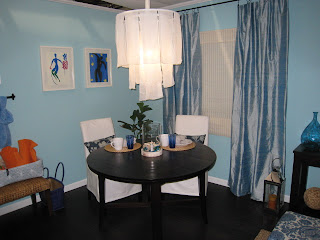

Color is a powerful tool! Pick the right colors, and you will love your room. Pick the wrong ones, and the opposite will happen. Look at these two pictures. The bottom one is a dining room before colors on the walls, the top is after.
Here are my 6 top advice for finding a color scheme that works for you:
1. Think about your favorite color in general
Take some time to think about what colors that generally makes you feel good. Look at what colors you like to wear. You can even think about what type of landscape and season that inspires you. For example, if you usually dress in neutrals and black, your favorite vacation is a week on the beach, and summertime is your favorite season, most likely you will feel good in a room filled with light sandy neutrals dressed up with blues and greens or maybe yellow.
2. Find a main color.
When you have reflected over your favorite colors, the next step is to find the main color for the home. My recommendation is usually to make this color a neutral. Neutral does not only mean beiges or tans, but can be a neutral yellow, green, or something else that you like. This color is the color that will be repeated throughout hallways and will also usually be used in some of the main rooms, such as the family room and/or dining and living rooms.
3. Use the color wheel.
The color wheel provides for many different color schemes, but these two are the easiest to work with: Complementary color scheme, which uses colors that are across from each other on the color wheel. Examples of these color schemes are blue and orange, green and red, or yellow and purple. Generally speaking, the complementary color scheme works best in formal areas of a house.
The other one is the analogous color scheme, which uses colors that are right next to each other on the color wheel, such as yellow and green, blue and green, or red and orange. This color scheme works best in the more private spaces, such as family rooms and bedrooms.
4. Colorize vertically.
It almost always works to decorate a room from dark to light vertically. Using this method, the floor will be darkest, and going up, the colors should get lighter. Think about nature, and how the ground has the darker values, the trees has the medium values, and the sky has the lightest values.
5. Use the 60-30-10 rule.
What this means is that you should use 60% of one color in a room (typically the walls and a little bit more), 30% of another color (typically upholstery and window treatments), and 10% of an accent color. Try it – it works!
6. Always use some black.
This is so easy, and it really works! By always adding something black to a room all the other colors will be enhanced. The room will feel more elegant and defined.
















